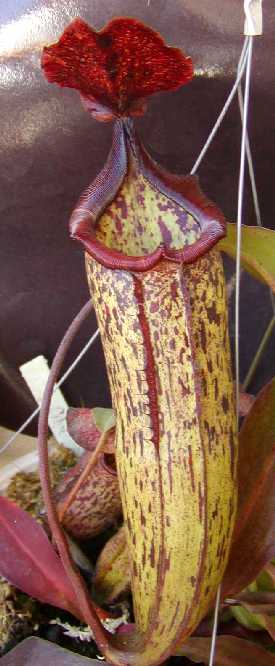
upper pitcher (photo taken 12 / 06)

upper pitcher (photo taken 12 / 06)



Nepenthes X mixta is a hybrid between N. northiana and N. maxima. The peristome is very striking because it has subtle maroon striping. My first specimen I bought from California Carnivores years ago grew in a terrarium and did well. That one seemed to have a more cylindrical, N. maxima looking peristome than the one I purchased from the CP Jungle. I eventually gave it away when I had to move. I've been told that the true N. x mixta comes from cuttings off of one original Victorian hybrid plant and it is supposed to be a male. I think they call that a cultivar. I have also heard that in some other crosses N. maxima "superba" was used as one of the parents. So there may well be several varieties of N. X mixta circulating around. Because both parent plants are pretty common, it's possible to make crosses of different N. northiana and N. maxima. However, I don't believe you can truly call it a N. X mixta. I've only seen this plant available from cuttings. Another note is that my CP Jungle N. X mixta is a female and the true Victorian hybrid N. X mixta is a male. So this plant may be a N. northiana X N. maxima but not the "true" N. X mixta. The plant I bought on Ebay came from a grower that assured me that this is indeed a cutting from the original Victorian hybrid. That cutting had two nice sideshoot growth points when it was sent to me. I decided to grow it outdoors similar to my other N. x mixta. I have had great success growing this lowlander / intermediate outdoors as a highlander. Both plants have been very vigorous, and I cut back my bigger specimen for cuttings on occasion. I'm really surprised because N. northiana is difficult for me to grow indoors under lower humidity so I expected N. x mixta to give me some trouble but it hasn't. For me, this guy has produced good sized pitchers in highland conditions without any side effects probably because of the N. maxima in it. When it comes to adapting possible lowlanders outdoors, vendors growing them usually give pretty good advice how their plants adjust to different temperatures, humidity, etc. in their greenhouses. This hybrid is definitely worth a try outdoors.
RATING
lowlander / intermediate / highlander (not a naturally occurring hybrid)
Cultivation: easy; vigorous grower outdoors; quicker as an indoor specimen
under lowland conditions
Market availability: rooted cuttings; available
Species variability: shouldn't be any if it is the
original Victorian hybrid from cuttings
$ / size: moderate; $35.00 and up for rooted
cuttings
Cuttings: available at times for trade
Sex: CP Jungle clone is female